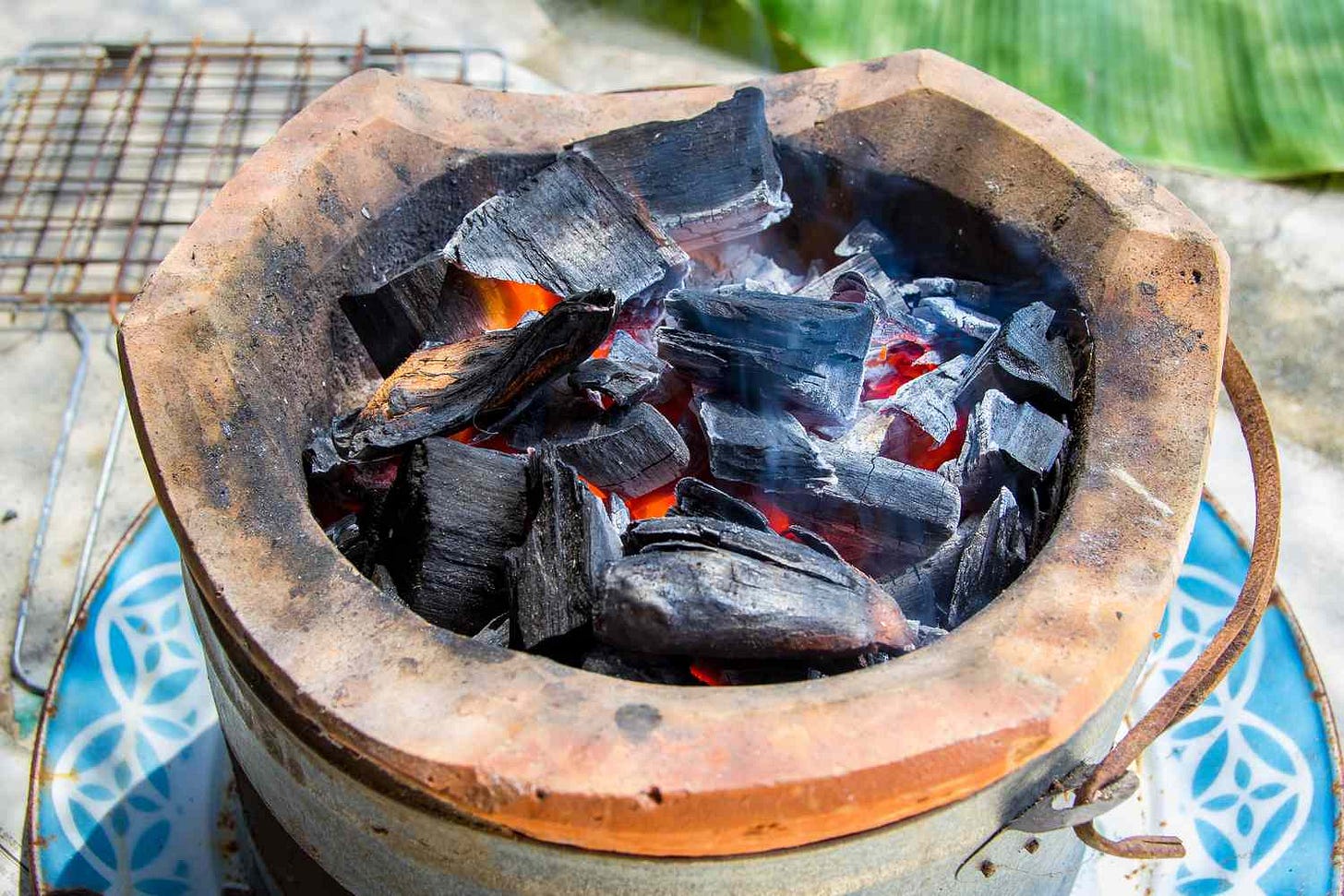Luxury white charcoal
Binchotan beginnings
If I was to tell you that this image above is this highly valued luxury good, I’m sure you would believe me. It may be a tough item to differentiate from almost any other burning item, particularly another charcoal bucket.
Binchotan is a very specific form of charcoal. Often known as white charcoal, this would actually be a good present if found in a Christmas stocking. Yes, it’s the world’s most expensive charcoal. This is not the same as the being the world’s smallest giant or other contradictory statements. This product is bespoke.
Made from Japanese Oak, normally Ubame, the process of creating binchotan is more drawn out than simply heating wood. It all goes back to old Bicchuya Chozaemon (備中屋長左衛門), now better known as Bincho (備長). Back in the 1600s, he discovered a secret. A way to make charcoal (normally black), as a white product.
His town of Tanabe, Wakayama became famous nationwide as the only place to find this product. As Bincho’s Tan (Japanese for coal), became even more popular, the surrounding cities and towns started adopting these methods/ stealing these secrets. Over centuries the methods of creating luxury coal have become more apparent and widespread. Yet the technical expertise and regional Ubame wood has meant that Wakayama still holds the title for where you want your best quality Binchotan. To be clear, it is still called binchotan even if it doesn’t comes from the Wakayama region of Japan, but you can look for sparkling charcoal elsewhere.
Burn Book
The following instructions for how to make this charcoal are based off a very detailed Japanese manufacturer on Youtube- found here for the full process in Japanese.
1. Find your tree.
This is easier said than done; the Ubame Oak grows in very hilly areas only, and in particular microclimates.
2. Cut the tree and bring wood to factory.
Again, easier said than done. The bringing of said tree is done by hand due to the aforementioned hilly terrain.
3. Into the kiln.
This is maybe the same said as done. The kiln is a specially made kiln that is very big and built for precise heating at a gradual pace. The hard part in this step is probably either sourcing or building a specific Binchotan kiln.
4. Light it on fire.
This is another difficult step which starts to make the high price seem downright reasonable. You first need to layer the wood properly so all of it is neat and consistently heated. Then also add in less dense wood to the kiln that burns quicker. Then time to seal it with brick, not before ensuring there are 4 tiny airflow/steam holes on the top and bottom. Then wait 9 hours.
5. Light it on fire again.
You previously just had burnt wood. Now you need to make charcoal. So a lower temperature heat, just burning for 6 or 7 days.
6 Seiren time
Step 5 got you the charcoal. Here is where the actual Binchotan technique comes in. This seems to be the most delicate step in a series of ever escalating delicate steps. The craftsmen will need to open up more holes to slowly increase the airflow. Yet the speed needs to be very carefully balanced, otherwise you just get dodgy charcoal and not Binchotan. Keep doing this 'until 1000 Celsius (i.e., only 24-48 hours for this step).
7. Cover it upThe Heat Is On
After all that, you need to keep your charcoal in a charcoal-y form. This means you can’t just be waiting for it to cool down and removing it (like most other charcoal manufacturing methods) since you’d be left with ash. Instead, you need to remove the Binchotan while it’s hot and cover it with sand and ash to keep the product at a gradual cool. After about 10 days, you’ll have your coal!
You may be forgiven in thinking that our old friend Bincho had spent too much time in the kiln, as this seems overly arduous for any amount of charcoal. Yet the demand has continued to grow ever since that fateful 17th Century day. To be honest, for most of its history, Binchotan was quietly burning along. Of course Japanese grillers, especially the yakitori and unagi restaurants, saw the benefits.
They saw the selling point of it basically being better across every metric you’d measure coal by. It burns hotter. Longer. Cleaner. While standard lump charcoal or briquettes last at most an hour or two, Binchotan is expected to burn 5 hours straight. Yet it is the even burning and smokeless heat that keeps the chefs coming back.
Not just coming back, but telling their friends.
The 2000s saw the chefs in those New York, London, and Paris restaurants that no one can afford, seeking authentic and pure Japanese materials in every aspect of cooking. They began importing Binchotan for their high-end robatayaki and yakitori grills. Binchotan found itself showing up in Michelin-starred kitchens, where chefs now treated it like a premium ingredient, not just a fuel source.
The chefs started boasting about them on their countless podcasts. Who talks about charcoal otherwise? That’s what makes Binchotan special. It transformed from a nearly invisible product to something chefs name-drop on menus.
by Leon, Hidden Japan | Read more:
Image: Food and Wine
Image: Food and Wine
